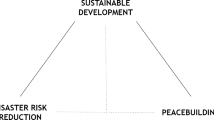Abstract
The current global and national regimes of governance are driven through and by the three international frameworks, viz. Sustainable Development Goals, Paris Climate Agreement and Sendai Framework for Disaster Risk Reduction over 15 years (2015–30) along with national, regional and local priorities In order to achieve the targets set under these goals, instruments for effective governance need to be reviewed, updated and re-installed with greater integration and vigour at relevant levels. In most instances, these by default cover the policies and regulatory provisions concerning disaster risk and resilience. Necessary integration of DRR and development goals has been recognized at the national and global level. Environmental governance is central to an integration of disaster management, climate resilience and sustainability goals. A range of instruments are in place to cater various aspects of environmental governance, ranging from assessment, planning, decision-support system, enforcement and monitoring tools, that includes EIA and SEA, Life-cycle Assessment, Risk Analysis, Auditing, Environmental Legislation. Their incorporation in disaster management helps facilitate policy integration of Sendai Framework on Disaster Risk Reduction (SFDRR 2015) and SDGs objectives. Present paper reviews the existing environmental-policy instruments that are relevant to disaster management applications. It also analyzes the role of EIA (Environmental Impact Assessment) and Environmental legislation including examples from Asian countries and discussing the usefulness and appropriateness of these tools that are useful in disaster risk reduction and management.
Access this chapter
Tax calculation will be finalised at checkout
Purchases are for personal use only
Similar content being viewed by others
References
Burton, I., R. W. Kates and G. F. White (1993). Environmental Hazards. London: The Guildford Press.
Dynes, R. (2004). Expanding the Horizon of Disaster Research. Natural Hazards Observer, 28(4): 1–2.
Gupta, A. K., A. Kumar, J. Misra and M. Yunus (2002). EIA & Disaster Management: Principles, Methodological Approach & Application. In: Bioresources & Environment (eds: Y. C. Tripathi and G Tripathi), Campus Books International, New Delhi.
Gupta, A. K. and S. S. Nair (eds.) (2011). Environmental Knowledge for Disaster Risk Management—Concept Note. In: Abstract Book of the International Conference, 9–10 May 2011, National Institute of Disaster Management, New Delhi and GIZ Germany. P 117.
Gupta, A. K, and Nair, S. (2012). Environmental Impact Assessment: Elucidating Policy-Planning for Natural Disaster Management. In: Ecosystem Approach to Disaster Risk Reduction (eds: A. K. Gupta and S. Nair). NIDM New Delhi. PP 164–186.
Gupta, A. K., Nair, S. and Dhyani, S. (2019). Mainstreaming Disaster Risk Reduction in EIA/SEA for Resilient Development. In: Climate Change and Disaster Management. Ministry of Environment Forests and Climate Change, Govt. of India and National Institute.
Gupta, A. K. and M. Yunus (2004). Indian and WSSD (Rio + 10) Johannesburg: Issues of National Concern and International Strategies. Current Science, 87(1): 37–43.
Harashima, Y. (2000). Environmental Governance in Selected Asian Developing Countries. International Review for Environmental Strategies, 1(1): 193–207.
Hazan, P. (1993). Human Rights and the Environment: A South Asian Perspective. Keynote Address at the 13th Informal ASEM Seminar on Human Rights. French Ministry of Foreign and European Affairs, hosted by the Danish Institute of Human Rights, 21–23 October 2013, at Copenhagen, Denmark.
Huppes, G. and U. E. Simonis (2001). Environmental Policy Instruments is a New Era. Research Professorship Environmental Policy, FSII 01-404, Science Center Berlin. http://www.wz-berlin.de/uta.
King, P., D. Annandale and J. Bailey (2000). A Conceptual Framework for Integrated Economic and Environmental Planning in Asia. Journal of Environmental Assessment Policy and Management 2 (3): 279–315.
King, P. N. and H. Mori (2007). The Development of Environmental Policy. International Review for Environmental Strategies, 7(1): 7–16.
Lidskog, R. (2013). Extreme Events, Regulatory Style and Regional Environmental Governance. In: Comparing Regional Environmental Governance in East Asia and Europe (EE-REG), Proceedings 24–25 January 2013, Kyoto, Japan, University of Geneva (Eds: Jörg Balsiger, Aysun Uyar). PP 53–62.
Mahapatra, R. (2011). True measure of Growth: GDP Grows at Environmental Cost—Can This Be Reversed? Down to Earth, 20 (9): 66.
Najam, A., M. Papa and N. Taiyab (2006). Global Environmental Governance: A Reform Agenda. International Institute for Sustainable Development. Manitoba, Canada.
NSET, UNDP, and ECHO, ‘NSDRM Draft 2008’.; Nepal National Planning Commission, ‘Three Years Interim Plan (2007–2010)’ (Kathmandu: Nepal National Planning Commission, Government of Nepal. http://www.npc.gov.np/en/plans-programs/detail.php?titleid=19.
Polack, E., E. M. Luna, J. Dator-Bercilla (2010). Accountability for Disaster Risk-Reduction: Lessons from the Philippines, CDG Working Paper 2, Brighton: CDG. www.climategovernance.org.
Shelton, D., and A. Kiss (2005). Judicial Handbook on Environmental Law. United Nations Environment Programme, Nairobi, Kenya.
UNEP and UNISDR (2010). Environment and Disaster Risk: Emerging Perspective. United Nations Environment Programme, Post-Conflict and Disaster Management Branch, Geneva, Switzerland. http://postconflict.unep.ch.
UNEP, UNISDR-PEDRR (2010). Opportunities in Environmental Management for Disaster Risk Reduction: Recent Progress—A Practice Area Review. In: Contribution to the Global Assessment Report on Disaster Risk Reduction. Special circulation.
Websites of UNEP, UN-OCHA, UN-ISDR, National Governments, Ministries, Academic Institutions, and unpublished literature and reports.
Author information
Authors and Affiliations
Editor information
Editors and Affiliations
Rights and permissions
Copyright information
© 2020 The Author(s)
About this chapter
Cite this chapter
Gupta, A.K., Dhyani, S., Nair, S.S., Singh, S. (2020). Environmental Governance for Resilience & SDGs. In: Malhotra, V.K., Fernando, R.L.S., Haran, N.P. (eds) Disaster Management for 2030 Agenda of the SDG. Disaster Research and Management Series on the Global South. Palgrave Macmillan, Singapore. https://doi.org/10.1007/978-981-15-4324-1_17
Download citation
DOI: https://doi.org/10.1007/978-981-15-4324-1_17
Published:
Publisher Name: Palgrave Macmillan, Singapore
Print ISBN: 978-981-15-4323-4
Online ISBN: 978-981-15-4324-1
eBook Packages: Business and ManagementBusiness and Management (R0)




